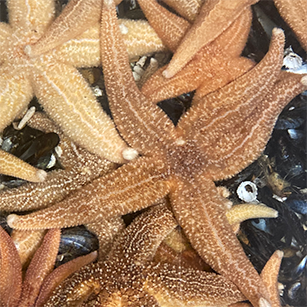Starfish hold the key to understanding neurohormone evolution
Research from academics at Queen Mary University of London School of Biological and Behavioural Sciences, published today in PNAS, has revealed a new perspective on the evolutionary origin of a neurohormone that regulates growth in humans.

Specimens of the common European starfish Asterias rubens; photograph taken by Ana B. Tinoco
Neurohormones are chemical messenger molecules that are released by neurons in the brain and then enter the bloodstream, where they travel to other target sites within the body. The neurohormone somatostatin inhibits release of growth hormone from the pituitary gland. Furthermore, analogs of somatostatin are used therapeutically to treat growth disorders such as gigantism and acromegaly.
Insects also produce a somatostatin-like substance that regulates growth-related processes and it is known as allatostatin-C. Somatostatin and allatostatin-C were previously thought to be orthologous, i.e., equivalent neurohormones in humans and insects that evolved from one common ancestral gene after evolution had given rise to different species.
This was until the researchers discovered that starfish have both neurohormones. Thus, the researchers have obtained evidence that somatostatin and allatostatin-C are paralogous, meaning that in the common ancestor of vertebrates, starfish and insects there would have been a gene duplication that gave rise to both hormones. But only one of the neurohormones was retained in vertebrates (somatostatin) and insects (allatostatin-C).
The researchers then proceeded to investigate the roles of the two neurohormones in starfish and discovered that they have opposing effects on muscles – with the somatostatin-type molecule having inhibitory (relaxing) effects and the allatostatin-C-type molecule having excitatory (contracting) effects.
Dr. Ya Zhang, who contributed to the study as part of her PhD studies at Queen Mary University of London, said, “This completely changes the way in which anyone working on somatostatin/allatostatin-C-type neurohormones approaches interpretation of their findings. If you want to make direct comparisons between species, you need to be sure you are looking at the equivalent genes and not a paralogue. It makes a big difference in terms of what functions they might have.”
The value of studying starfish
Echinoderms (starfish, sea urchins, sea cucumbers) are the only animal phylum so far where both of these neurohormones are found together, which emphasises the importance of studying a range of different model species.
Maurice Elphick, Professor of Animal Physiology & Neuroscience and lead author of the study said, “One of the reasons why we work on starfish is because they are fascinating of course, but also because they are an animal that appears to have retained ancestral genes to a greater extent than other more often-studied animals, such as vertebrates and insects.”
The researchers found that in starfish, the two neurohormones have diverged extensively in terms of their function, which is likely why they have both been retained. Whereas it is speculated that both neurohormones have not been retained in other animals as they have similar functions and are therefore dispensable. However, it is not fully understood how the two neurohormones exert their opposing effects in starfish, and future research will be directed toward addressing this.
How did they go about this?
Discovery and characterisation of the genes encoding the two neurohormones in starfish was facilitated by sequencing of the genome of the common starfish Asterias rubens, which was accomplished by a collaboration between Prof. Elphick’s group and the Wellcome Sanger Institute as part of the 25 Genomes Project and Darwin Tree of Life Project. The genome enabled the researchers to analyse the sequences, structures and chromosomal positions of the genes encoding the two neurohormones in comparison with other animals.
To investigate where the two neurohormones are produced within the starfish body the researchers used techniques known as mRNA in situ hybridisation and immunohistochemistry, which enabled visualisation of expression of the genes encoding the neurohormones and the neurohormones themselves in cells. Then to investigate the roles of the neurohormones in starfish, pharmacological experiments were performed to test the effects of the neurohormones on three different muscles/organs from the animal. The allatostatin-C-type molecule was found to cause muscle contraction in all cases, contrasting with findings of a previous study by Zhang et al., which reported that the somatostatin-type molecule causes muscle relaxation.
The research was supported by funding from the Biotechnology and Biological Sciences Research Council, Leverhulme Trust, China Scholarship Council, Mexican Council of Science and Technology (CONACyT) and Queen Mary University of London.
More information
Ya Zhang, Luis Alfonso Yañez-Guerra, Ana B. Tinoco, Nayeli Escudero Castelán, Michaela Egertová, Maurice R. Elphick (2022) Somatostatin-type and allatostatin-C-type neuropeptides are paralogous and have opposing myoregulatory roles in an echinoderm. Proc. Natl. Acad. Sci. USA, 119, e2113589199 https://doi.org/10.1073/pnas.2113589119